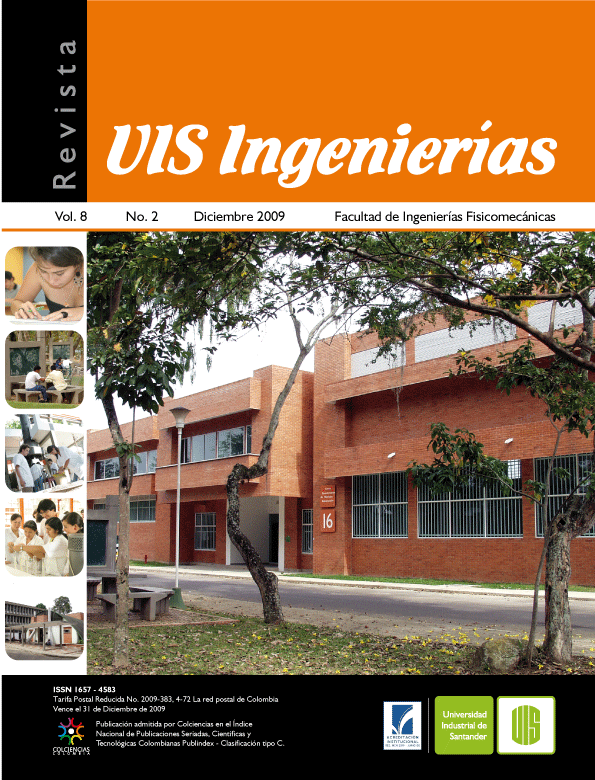Articles
Modeling declared preferences for obtaining indicators of the quality of urban public transport service quality
Published 2009-12-02
Keywords
- Selection experiment,
- discrete selection modelling,
- stated preferences
How to Cite
Jaimes Monsalve, H., & Dueñas Ruiz, D. E. (2009). Modeling declared preferences for obtaining indicators of the quality of urban public transport service quality. Revista UIS Ingenierías, 8(2), 113–125. Retrieved from https://revistas.uis.edu.co/index.php/revistauisingenierias/article/view/503
Abstract
This paper presents the results of stated-preference, discrete selection experiments designed to obtain quality indicators in the urban public transport service in the town of Barrancabermeja, which was raised to two alternatives that contain the attributes : fare, walking distance from origin to fate, waiting time at bus stop, travel time in vehicle, availability of seats, driver and vehicle, generating a Multinomial Logit model, which allows the city to complete study attributes most relevant to the quality of the service are: 32.6% rate, walking distance from the origin to the whereabouts 18.0% and 14.3% travel time.
Downloads
Download data is not yet available.
References
Train, K. (2003). Discrete Choice Methods with Simulation. Cambridge University Press, Cambridge.
Louviere, J.J., Hensher, D.A. y Swait, J.D. (2000) Stated Choice Methods: Analysis and Applications. Cambridge University Press, Cambridge.
Lancaster, K.J. (1966) A new approach to consumer theory. Journal of Political Economy 14, 132-157.
Bradley, M.A. y Daly, A. J. (1997) Estimation of logit choice models using mixed stated preference and revealed preference information. In P.R. Stopher and M. Lee-Gosselin (eds.), Understanding Travel Behaviour in an Era of Change, Pergamon, Oxford.
Ben-Akiva, M.E. y Morikawa, T. (1990) Estimation of travel demandmodels from multiple data sources. Proceedings 11th InternationalSymposium on Transportation and Traffic Theory, Yokohama
Universidad Pedagógica y Tecnológica de Colombia. Convenio 0870-04 suscrito entre la Universidad, el Municipio de Barrancabermeja y La Inspección de Tránsito y Transporte de Barrancabermeja, para la Reestructuración de Rutas de Transporte Público Urbano de Barrancabermeja (2005)
Ortúzar, J. de D., Ivelic, A.M. y Candia, A. (1997)User perception of public transport level-ofservice. En P.R. Stopher y M. Lee-Gosselin (eds.), Understanding Travel Behaviour in an Era of Change, 123-142, Pergamon, Oxford.
Garrido, R. A. y J. de D. Ortúzar (1994) Deriving public transport level of service weights from multiple comparison of latent and observable variables. Journal of the Operational Research Society, 45 (10), 1099-1107.
Hensher, D.A., P. Stopher y P. Bullock (2003) Service quality–developing a service quality index in the provision of commercial bus contracts. Transportation Research Part A 37, 499–517.
Dueñas R, Domingo Ernesto. Calidad del servicio en el sistema de transporte público en autobuses en ciudades pequeñas e intermedias del ámbito Latinoamericano. Tesis Doctoral. Universidad Politécnica de Valencia UPV. Valencia España, junio de 2000
Mackie, P. J., S. Jara-Díaz y A. S. Fowkes (2000). The Value of Travel Time Savings in Evaluation. Final Report. 2000.
Zwerina, K., J. Huber and W. F. Kuhfeld (1996). A General Method for Constructing Efficient Choice Designs.
Koçur, G., T. Adler, W. Hyman and E. Audet (1982) Guide To Forecasting Travel Demand With Direct Utility Measurement, UMTA, USA Department of Transportation (Washington D.C.). Tablas escaneadas.
Street, D., L. Burgess and J. Louviere (2005). Quick and easy choice sets: Constructing optimal and nearly optimal stated choice experiments
Louviere, J.J., Hensher, D.A. y Swait, J.D. (2000) Stated Choice Methods: Analysis and Applications. Cambridge University Press, Cambridge.
Lancaster, K.J. (1966) A new approach to consumer theory. Journal of Political Economy 14, 132-157.
Bradley, M.A. y Daly, A. J. (1997) Estimation of logit choice models using mixed stated preference and revealed preference information. In P.R. Stopher and M. Lee-Gosselin (eds.), Understanding Travel Behaviour in an Era of Change, Pergamon, Oxford.
Ben-Akiva, M.E. y Morikawa, T. (1990) Estimation of travel demandmodels from multiple data sources. Proceedings 11th InternationalSymposium on Transportation and Traffic Theory, Yokohama
Universidad Pedagógica y Tecnológica de Colombia. Convenio 0870-04 suscrito entre la Universidad, el Municipio de Barrancabermeja y La Inspección de Tránsito y Transporte de Barrancabermeja, para la Reestructuración de Rutas de Transporte Público Urbano de Barrancabermeja (2005)
Ortúzar, J. de D., Ivelic, A.M. y Candia, A. (1997)User perception of public transport level-ofservice. En P.R. Stopher y M. Lee-Gosselin (eds.), Understanding Travel Behaviour in an Era of Change, 123-142, Pergamon, Oxford.
Garrido, R. A. y J. de D. Ortúzar (1994) Deriving public transport level of service weights from multiple comparison of latent and observable variables. Journal of the Operational Research Society, 45 (10), 1099-1107.
Hensher, D.A., P. Stopher y P. Bullock (2003) Service quality–developing a service quality index in the provision of commercial bus contracts. Transportation Research Part A 37, 499–517.
Dueñas R, Domingo Ernesto. Calidad del servicio en el sistema de transporte público en autobuses en ciudades pequeñas e intermedias del ámbito Latinoamericano. Tesis Doctoral. Universidad Politécnica de Valencia UPV. Valencia España, junio de 2000
Mackie, P. J., S. Jara-Díaz y A. S. Fowkes (2000). The Value of Travel Time Savings in Evaluation. Final Report. 2000.
Zwerina, K., J. Huber and W. F. Kuhfeld (1996). A General Method for Constructing Efficient Choice Designs.
Koçur, G., T. Adler, W. Hyman and E. Audet (1982) Guide To Forecasting Travel Demand With Direct Utility Measurement, UMTA, USA Department of Transportation (Washington D.C.). Tablas escaneadas.
Street, D., L. Burgess and J. Louviere (2005). Quick and easy choice sets: Constructing optimal and nearly optimal stated choice experiments

